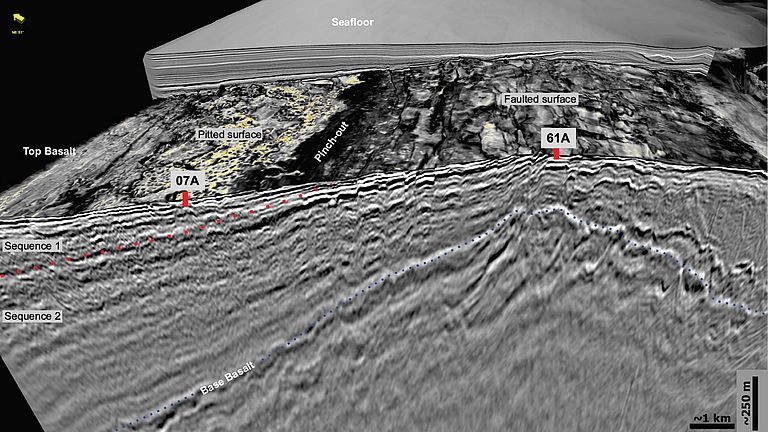PERBAS: In search of safe carbon dioxide storage in offshore basalt rocks
In a new project, ten partners from industry and science investigate technologies for the storage of carbon dioxide in marine basalt structures
In order to limit global climate change as laid down in the Paris Agreement, emissions of carbon dioxide (CO2) need to be cut drastically. In addition, solutions for further reduction need to be developed. The storage of CO2 underground has been identified as one possible option. To avoid risks for populated areas and groundwater and to achieve safe storage for centuries, possible sites are being explored in the seabed – for example in former oil and gas fields or in sandstone formations. Because these reservoirs are estimated to only reach half the required volume, also basalt deposits are increasingly being tested for their potential suitability.
These rock formations are also at the focus of a new research consortium funded by the European Research Area Network (ERA-NET) through the Accelerating CCS Technologies (ACT) initiative: PERBAS (Permanent sequestration of gigatons of CO2 in continental margin basalt deposits) aims to further investigate the technology of CO2 storage in marine basalt complexes and to provide the necessary framework parameters for industrial planning. To this end, ten companies and public research institutions from Germany, Norway, the United States of America and India are working together under the leadership of Dr. Jörg Bialas, marine geophysicist at GEOMAR Helmholz Centre for Ocean Research Kiel. The participating countries contribute a total funding of 3.6 million euros for three years. GEOMAR receives about 800,000 euros from the Federal Ministry for Economic Affairs and Climate Action for its contributions. In July 2023, all participants met at GEOMAR for the joint project launch.
“Test fields such as CarbFix in Iceland and Wallula in the United States have shown that basalt deposits could offer a good alternative,” explains Dr Bialas. “When CO2 is stored in basalt rock, a mineralogical conversion of the injected carbon into carbonate is initiated together with water. The carbonate is permanently deposited as a solid in the subsoil. Subsequent leakage and unintentional emission of CO2 are thus ruled out. The conversion reaction takes place relatively quickly: In the test fields, 98 per cent of the injected carbon was permanently deposited within two years.”
Basalt complexes are suspected to exist off the coasts of Northern Europe, but also on the American or Indian continents, which are expected to have a storage volume of up to 40 terra tonnes of carbon. PERBAS will analyse the chemical and physical composition of such deposits in order to describe their pore characteristics, the possible mineralisation and their technical accessibility. These characteristics will lead to a cataloguing of suitable basalt complexes. Further investigations will further develop geophysical methods for an economic monitoring of such deposits and show their limits.
“We want to provide the industry with the necessary basic information as a complete package so that they can economically evaluate and plan future storage projects in a geological environment that has not been used so far,” announces Dr Bialas.
Project Partners:
The Arctic University of Norway, Norway
Volcanic Basin Energy Research AS, Norway
Institute for Energy Technology, Norway
Lawrence Berkely National Laboratory, United States of America
Colorado School of Mines, United States of America
National Geophysical Research Institute, India
Indian Institute of Technology Roorkee, India
Indian Institute of Science Education and Research Bhopal, India
TEEC GmbH, Germany

PERBAS Logo

Three-dimensional section through the Skoll High basalt complex in the Vøring Plateau off the coast of Norway showing test drillings (07A and 61A) from 2022. Graphic: VBER


